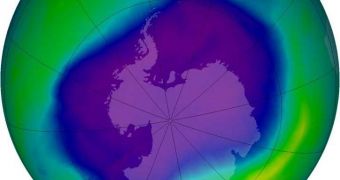Despite the fact that the production of chlorofluorocarbons has been forbidden for decades via an international agreement, the chemicals continue to damage Earth's ozone layer. This was made apparent again this year, as the Antarctic ozone layer hole reached its maximum annual extent.
The hole becomes most visible during spring in the Southern Hemisphere. Its annual peak for 2011 was reached on September 12, when investigators measured it as having a surface of around 10.05 million square miles (26.03 million square kilometers).
“The colder than average temperatures in the stratosphere this year caused a larger than average ozone hole,” says the NASA Goddard Space Flight Center (GSFC) chief scientist for atmospheres, Paul Newman.
“Even though it was relatively large, the area of this year's ozone hole was within the range we'd expect given the levels of man-made ozone-depleting chemicals that continue to persist in the atmosphere,” he adds.

 14 DAY TRIAL //
14 DAY TRIAL //